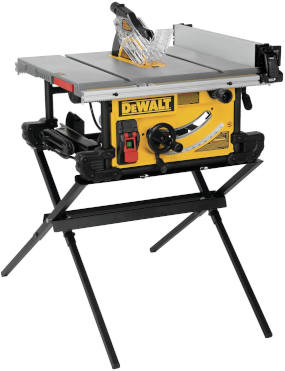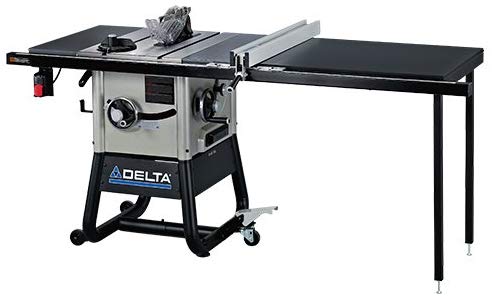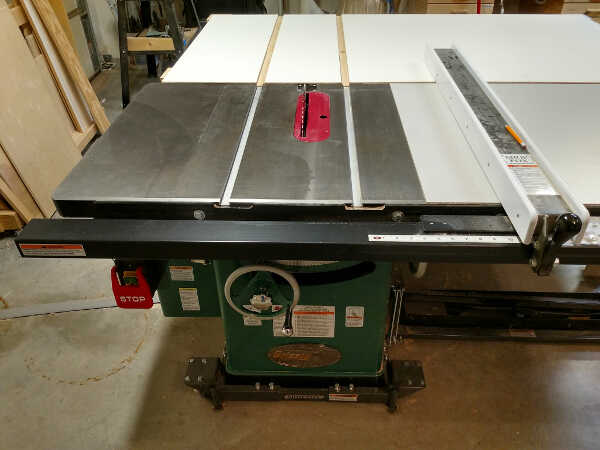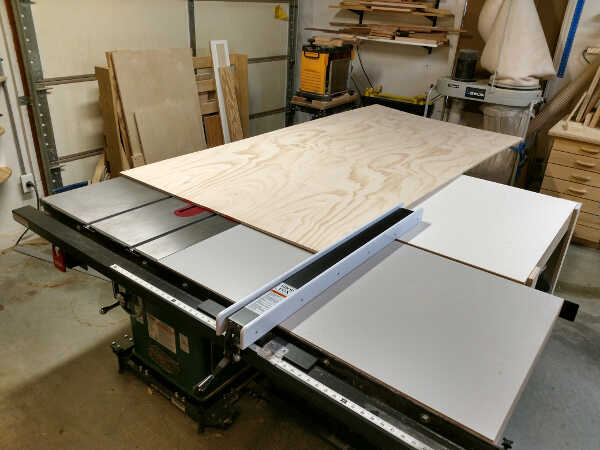How To Choose A Table Saw To Get The Most For Your Woodworking


When you’re trying to research how to choose a table saw and you’re hit with what seems like an overwhelming amount of options, within a huge span of price ranges… Yeah, shopping for a table saw can be frustrating.
I’ve moved from a lightweight, jobsite type of saw, up to a heavier hybrid style with a mobile base, and finally up to a stationary 3 horsepower saw. So I’ve done my share of research and had experience with the different saw types.
Below I’ll walk you through the process of choosing a table saw for your wood shop. We’ll go over the different types, the pros and cons of each, and which features should matter most to you depending on things like your budget, shop size, and project needs.
Let’s dive right in…
Consider Your Budget
A table saw can easily be the largest investment you make for your wood shop.
Understanding your options and how much you are willing to spend is a good first step in filtering through all the options available today.
You can spend a few hundred bucks for a cheap or a used table saw. You could also spend a few thousand bucks on a brand new high-dollar fancy table saw. Or you could spend anywhere in between.
A decent, heavy duty table saw will probably run you in the range of $1,000 to $1,500.
But as you dig deeper into your available choices, you may find practical and high-quality saws for a bit less, or you may settle in on a premium table saw for quite a bit more.
The point is this, prepare yourself to spend a big chunk of change on this tool. You’ll be doing so for a good reason. For most any woodworker, the table saw is the central, most important tool in the shop.
So don’t skimp out and buy some bargain-level cheaply made saw, just because it has some neat features.
Always consider quality when doing your research on such an important tool.
What’s Your Shop Ultimately Going To Include (power tools)
If you’re equipping a full-blown, well-tooled wood shop, that should be taken into consideration when looking at table saws.
For example, if you have a track saw for breaking down plywood, then you don’t need a table saw with a really wide side table made for supporting plywood.
However, if you’re limited on space, then you have to choose your tools carefully, always considering their footprint and overall bulkiness.
One thing to consider is for a small shop, you can do a lot with a table saw even by itself. By that I mean you don’t necessarily need a miter saw, track saw, or radial arm saw, if you get yourself a decent table saw.
So if you’ve been considering these other tools, maybe you should instead invest that money into getting a better or bigger table saw.
The 3 Different Table Saw Categories
Portable Table Saw


See this one on Amazon
The small, mobile, lightweight table saws, often called jobsite saws, are part of the Portable Table Saw class.
These use regular 120 volt power, and are typically lightweight enough you can pick them up and move them around easily.
Some are a bit heavier, and may come with a mobile base to make it easier.
They usually come with an aluminum top, to which the motor is attached.
Many versions do not have standard miter slots, making it difficult to build custom sleds and jigs for, or even feather boards. And more often than not, the saw’s factory miter gauge will have some slop to it, making it less than perfect for cross cutting or cutting accurate miters.
The arbor is shorter to keep you from using stacked dado blades. These heavier blades require more power, which the smaller motor can’t handle. So don’t plan on using a stacked dado blade set if you get a small, jobsite table saw.
There are some exceptions to this, as I’ve come across a few of the higher end portable saws that claim they support dado blades, but it’s not the norm.
The cheaper built body and aluminum top means you may not have a perfectly flat surface to work on (compared to higher dollar saws which use cast iron for their tops, a heavier metal that holds its flatness).
The table is pretty small, which can be offset by building a work bench around your portable table saw, providing a larger side and outfeed table. You can also get creative a build a custom fence system to increase your rip capacity and accuracy.
All in all, a small portable table saw may be a good starting point if you just need to do some basic ripping and crosscutting on some not-so-advanced projects. Look at spending somewhere in the range of $300 to $700.
Features to look for are extra rip capacity with an extendable wing, a mobile base, carrying handles, dust extraction, blade guard, standard 3/4″ wide miter slots, and a tightly secured fence when locked down (make sure there’s no play).
Hybrid Table Saw


See this saw on Amazon
A hybrid (sometimes called a contractor saw) is a mix between a portable saw and a cabinet saw.
A hybrid saw will still use standard 120 volt power supply. Their motors are also mounted to the table top.
And they typically have an open base, possibly even mounted on wheels to make it mobile.
They are built much heavier duty than the portable saws. They use a heavier gauge metal and beefier parts overall.
Hybrid table saws usually have cast iron tops, but may use steel wings to reduce overall weight (instead of full cast iron from end to end).
They’ll come with the standard 3/4” miter slots, making the use of cross cut sleds, miter sleds, and other various table saw sleds and jigs a possibility.
See my premium collection of shop jig project plans here
The rails will support a more accurate fence, and their miter gauges will be tighter with less slop to them.
The motor is big enough to handle the added weight of a stacked dado blade set, so the arbor is made big enough to support one.
A hybrid saw is a big upgrade from a portable saw, and that’s reflected in the price. You’ll find good hybrid saws in the range of $600 to $2,000, depending on features.
Things to look for in a good hybrid table saw – 3/4” standard miter slots, mobile base, Biesemeyer-style single-lockdown fence, vibration-free, built in dust extraction, and does it come with a dado blade throat plate.
Cabinet Saw


See this saw on Amazon
Cabinet saws are the highest cost, and heaviest of the table saws. These have an enclosed base to which the motor is attached. This puts less stress on the top overtime, and makes precision-tuning easier.
The top is larger and made of cast iron. Though some models with extended wings may have a section of steel, or smooth sheet material like coated mdf (seen above on my Grizzly saw).
The motor is likely a 3, or 5 horsepower. These are very powerful motors that pull more amps. You may find an option for a cabinet saw with a 1.75 hp motor on a 120 volt plug, but more likely they’ll require 240 volts.
They are not intended to be mobile, so when you put the saw together, you should probably do so in the location you want to leave it. These saws can easily weigh over 1,000 pounds.
The cabinet saw is the pinnacle of saws for woodworkers, and allow you to accomplish incredible, machine-like precision, while taking on advanced projects and thick, dense hardwoods.
These saws will set you back $1,500 to $4,000. Look for features you’ll need in your shop, like extended wings, an outfeed table, good dust extraction, Biesemeyer-style fence, quick-change blade guard and riving knife, smooth-sliding no-slop miter gauge, and a simple technique for blade-changes.
For a more in depth explanation of the mechanical parts in a saw, see this article on Rockler.
What Power Do You Have Available In Your Shop
So most garages and shops have standard power, which is 120 volts (sometimes referred to as 110 volt).
But this voltage can only support up to so much power, and the larger cabinet table saws require more power than 120 volts can handle.
If all you’ve got access to is 120, then the best you can likely do is a good hybrid table saw, or possibly a cabinet saw with a 1.75 horsepower motor (check nominal voltage before purchasing).
Should you consider upgrading your power to provide 240 volt circuits, then you can not only get a cabinet saw, but you’ll be able to invest in more powerful tools down the road. Plus, you can get better electric heaters for your shop, the ones that require 240 volts.
Do You Need To Break Down Full Sheets Of Plywood


Being able to break down full-sized plywood sheets is really handy for a woodworker.
If you’re interested in building more with sheet material like plywood, give this article a read.
A small portable table saw should not be used to cut heavy sheet material.
The wood can easily weigh more than the saw, and the saw itself may feel very unstable and could easily get tipped or shoved around, making for an unsafe cut.
Ripping sheet material lengthwise can be handled safely on any hybrid and cabinet table saw.
Cross cutting plywood sheets is more difficult, so if you want to be able to do this, you’ll need a hybrid or cabinet saw that has a large extension wing to one side.
This will make it possible to support large sheet material for cross cutting. This is absolutely fantastic for building cabinets and other casework.
Does Your Table Saw Need Mobility, Or Will It Be Stationary
Many small shop woodworkers will need a table saw pushed off to one side for regular use, while longer boards or plywood cutting may require relocating the saw to allow more clearance for the larger boards.
The smaller, portable saws can be purchased with a mobile base that has wheels.
Another choice for these small saws is to build a mobile workbench that holds and fully supports the saw, which can also provide for a wider table top and an outfeed table.
If you want a hybrid saw, I would suggest getting one with a retractable wheel base. These are designed to be raised up when not used, and lowered to make the entire saw fully mobile without having to tilt it.
And if you get a cabinet saw, chances are you don’t plan on moving it around too much, which is convenient because they’re very difficult to move.
However, you can get a mobile base for a cabinet saw. These make it possible to move the saw without disassembling it, but it’s not the same as a mobile hybrid table saw.
Even with the mobile base on a cabinet saw, you won’t be moving it very easily, or very quickly.
My suggestion is to only get a cabinet table saw if you plan on setting it up and leaving it in one place.
But still assemble it on to a mobile base, that way if you ever do need to relocate it, it’s humanly possible to do so…
Be sure to sign up below for woodworking tips, projects, and plans sent straight to your inbox.
Related:
Table Saw 101
Tuning Your Table Saw Fence
Table Saw Blades Explained
Beginner Woodworkers Start Here


